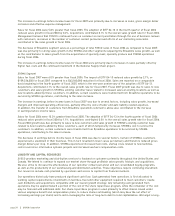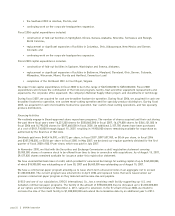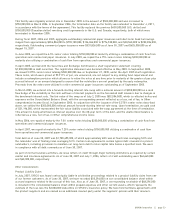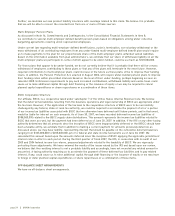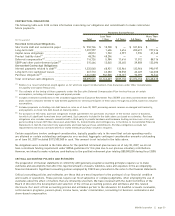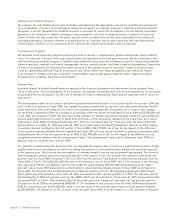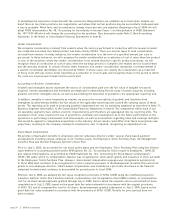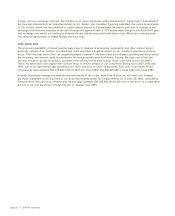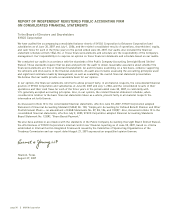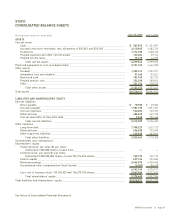Sysco 2007 Annual Report Download - page 54
Download and view the complete annual report
Please find page 54 of the 2007 Sysco annual report below. You can navigate through the pages in the report by either clicking on the pages listed below, or by using the keyword search tool below to find specific information within the annual report.In evaluating the exposures connected with the various tax filing positions, we establish an accrual when, despite our
belief that our tax return positions are supportable, we believe that certain positions may be successfully challenged and
a loss is probable. When facts and circumstances change, these accruals are adjusted. Beginning in fiscal 2008, we will
adopt FASB Interpretation No. 48, “Accounting for Uncertainty in Income Taxes — an Interpretation of FASB Statement
No. 109” (FIN 48) which will change the accounting for tax positions. (See discussion under Note 3, New Accounting
Standards, in the Notes to Consolidated Financial Statements in Item 8).
Vendor Consideration
We recognize consideration received from vendors when the services performed in connection with the monies received
are completed and when the related product has been sold by SYSCO. There are several types of cash consideration
received from vendors. In many instances, the vendor consideration is in the form of a specified amount per case or
per pound. In these instances, we will recognize the vendor consideration as a reduction of cost of sales when the product
is sold. In the situations where the vendor consideration is not related directly to specific product purchases, we will
recognize these as a reduction of cost of sales when the earnings process is complete, the related service is performed
and the amounts realized. In certain of these latter instances, the vendor consideration represents a reimbursement of
a specific incremental identifiable cost incurred by SYSCO. In these cases, we classify the consideration as a reduction
of those costs with any excess funds classified as a reduction of cost of sales and recognizes these in the period in which
the costs are incurred and related services performed.
Accounting for Business Combinations
Goodwill and intangible assets represent the excess of consideration paid over the fair value of tangible net assets
acquired. Certain assumptions and estimates are employed in determining the fair value of assets acquired, including
goodwill and other intangible assets, as well as determining the allocation of goodwill to the appropriate reporting unit.
In addition, annually or more frequently as needed, we assess the recoverability of goodwill and indefinite-lived
intangibles by determining whether the fair values of the applicable reporting units exceed the carrying values of these
assets. The reporting units used in assessing goodwill impairment are our six operating segments as described in Note 17,
Business Segment Information, to the Consolidated Financial Statements in Item 8. The components within each of our
six operating segments have similar economic characteristics and therefore are aggregated into six reporting units. The
evaluation of fair value requires the use of projections, estimates and assumptions as to the future performance of the
operations in performing a discounted cash flow analysis, as well as assumptions regarding sales and earnings multiples
that would be applied in comparable acquisitions in the industry. Actual results could differ from these assumptions and
projections, resulting in the company revising its assumptions and, if required, recognizing an impairment loss.
Share-Based Compensation
We provide compensation benefits to employees and non-employee directors under several share-based payment
arrangements including various employee stock incentive plans, the Employees’ Stock Purchase Plan, the Management
Incentive Plan and the Non-Employee Directors Stock Plan.
Prior to July 3, 2005, we accounted for our stock option plans and the Employees’ Stock Purchase Plan using the intrinsic
value method of accounting provided under APB Opinion No. 25, “Accounting for Stock Issued to Employees,” (APB 25)
and related interpretations, as permitted by FASB Statement No. 123, “Accounting for Stock-Based Compensation,”
(SFAS 123) under which no compensation expense was recognized for stock option grants and issuances of stock pursuant
to the Employees’ Stock Purchase Plan. However, share-based compensation expense was recognized in periods prior
to fiscal 2006 (and continues to be recognized) for stock issuances pursuant to the Management Incentive Plan and stock
grants to non-employee directors. Share-based compensation was included as a pro forma disclosure in the financial
statement footnotes and continues to be provided for periods prior to fiscal 2006.
Effective July 3, 2005, we adopted the fair value recognition provisions of SFAS 123(R) using the modified-prospective
transition method. Under this transition method, compensation cost recognized in fiscal 2006 includes: a) compensation
cost for all share-based payments granted through July 2, 2005, but for which the requisite service period had not been
completed as of July 2, 2005, based on the grant date fair value estimated in accordance with the original provisions
of SFAS 123, and b) compensation cost for all share- based payments granted subsequent to July 2, 2005, based on the
grant date fair value estimated in accordance with the provisions of SFAS 123(R). Results for prior periods have not
been restated.
page 28 ][ SYSCO Corporation




